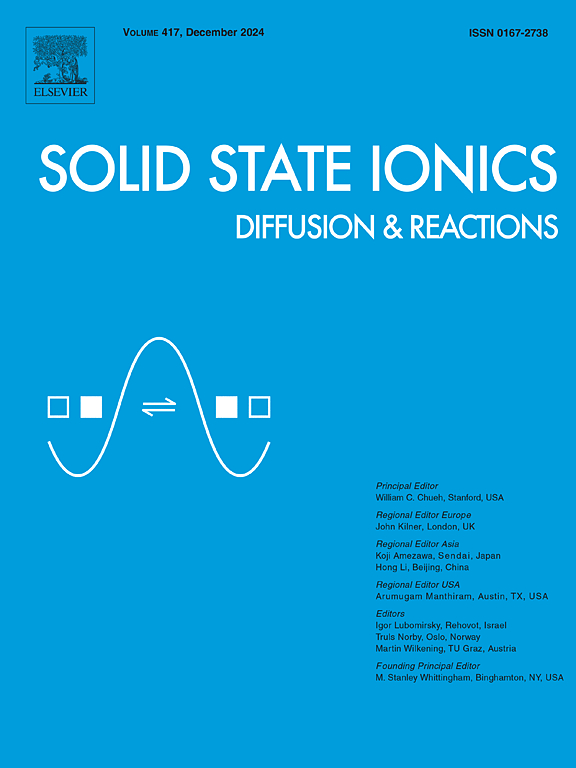基于高温热注入法制备的 CuInS2 量子点的敏化太阳能电池的性能改进战术
IF 3
4区 材料科学
Q3 CHEMISTRY, PHYSICAL
引用次数: 0
摘要
为了揭示量子点敏化太阳能电池(QDSSC)转换效率提高的途径和原因,采用高温热注入法在油相合成了黄铜矿结构的 CuInS2 量子点(QDs)。然后,用 3-巯基丙酸作为配体交换试剂和 QDs 负载诱导剂,将 QDs 从油相转移到水相。水相中的 3-巯基丙酸涂层 QDs 被敏化在 TiO2 纳米晶薄膜上,制成了 QDSSC。QDs的敏化时间和QDs溶液的pH值是影响QDs负载量和最终组装的QDSSC性能的两个重要因素。QDs 在 TiO2 多孔薄膜上的长时间敏化会导致 QDs 在薄膜上聚集和堆积。QDs 水溶液的 pH 值会影响 QDs 在溶液中的稳定存在和在 TiO2 表面的吸附。通过平衡上述两个因素的影响,CuInS2 QDs 的最佳敏化条件是在 pH = 11 的 QDs 溶液中吸附 2 小时。此外,QD 敏化 TiO2 多孔薄膜与 FTO 之间的界面也是影响 QDSSC 光电转换效率的另一个因素。通过在 QDSSC 上添加具有高导电性和电子迁移率的 Zn 掺杂 TiO2 致密层来改变该界面,QDSSC 的光电转换效率进一步提高了 66.4%。本文章由计算机程序翻译,如有差异,请以英文原文为准。
Performance improvement tactics of sensitized solar cells based on CuInS2 quantum dots prepared by high temperature hot injection
To reveal the ways and causes of conversion efficiency enhancement for quantum dot-sensitized solar cells (QDSSCs), chalcopyrite structure CuInS2 quantum dots (QDs) was synthesized in oil phase by the high temperature hot injection method. Then, QDs were transferred from oil phase to water phase with 3-mercaptopropionic acid as a ligand exchange reagent and loaded inducer of QDs. 3-mercaptopropionic acid coated QDs in water phase were sensitized on TiO2 nanocrystalline thin films to fabricate QDSSCs. The sensitization time of QDs and pH value in QDs solution are two important factors to affect the loading amounts of QDs and performance of the final assembled QDSSCs. Long-time sensitization of QDs on the TiO2 porous thin film will cause QDs to agglomerate and stack on the film. The pH of QDs aqueous solution influences the stable existence in solution of QDs and adsorption on the surface of TiO2. By balancing the influence of the above two factors, the optimal sensitization condition of CuInS2 QDs is adsorption in pH = 11 QDs solution for 2 h. In addition, the interface between QD-sensitized TiO2 porous thin film and FTO is another factor to affect the photoelectric conversion efficiency of QDSSCs. By adding Zn-doped TiO2 compact layer with high conductivity and electron mobility on QDSSCs to modify this interface, the photoelectric conversion efficiency of QDSSCs was further increased by 66.4 %.
求助全文
通过发布文献求助,成功后即可免费获取论文全文。
去求助
来源期刊

Solid State Ionics
物理-物理:凝聚态物理
CiteScore
6.10
自引率
3.10%
发文量
152
审稿时长
58 days
期刊介绍:
This interdisciplinary journal is devoted to the physics, chemistry and materials science of diffusion, mass transport, and reactivity of solids. The major part of each issue is devoted to articles on:
(i) physics and chemistry of defects in solids;
(ii) reactions in and on solids, e.g. intercalation, corrosion, oxidation, sintering;
(iii) ion transport measurements, mechanisms and theory;
(iv) solid state electrochemistry;
(v) ionically-electronically mixed conducting solids.
Related technological applications are also included, provided their characteristics are interpreted in terms of the basic solid state properties.
Review papers and relevant symposium proceedings are welcome.
 求助内容:
求助内容: 应助结果提醒方式:
应助结果提醒方式:


